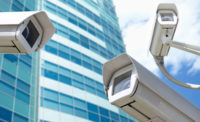Survey Says Most Police Departments Using Cameras

About one-third of all local police departments used body-worn cameras for at least some officers in 2013, according to a survey by the federal Bureau of Justice Statistics (BJS).
An estimated 32 percent of local police departments provided at least some officers with body-worn cameras and 6 percent provided at least some officers with weapon-attached cameras in 2013, the Bureau of Justice Statistics (BJS) announced.
The survey showed an uptick in other forms of technology and safety equipment. The percentage of the more than 12,000 local police departments that used in-car video cameras in 2013 (68 percent) was higher than in 2007 (61 percent). The number of local police departments authorizing the use of Tasers and stun guns increased more than tenfold between 2000 and 2013—up from 7 percent to 81 percent.
In 2013, about 9 in 10 local police departments allowed their officers to use pepper spray (94 percent) and batons (87 percent). Additionally, a majority of local police departments authorized defensive physical tactics including open-hand (91 percent), takedown (89 percent) and closed-hand (85 percent) techniques. Slightly less than 20 percent of local police departments allowed neck-restraint tactics.
Nearly 90 percent of local police departments were using some type of video camera technology in 2013. This included an estimated 17 percent that used automated license plate readers and about 49 percent that used video cameras for the surveillance of public areas. Small percentages of these departments also used unmanned aircraft systems (less than 1 percent) and gunshot detection systems (4 percent).
The percentage of local police officers employed by a department that provided in-field computer access also increased. Local police departments providing remote access to vehicle records employed 93 percent of all officers in 2013, compared to 86 percent in 2007. In 2000, 25 percent of departments transmitted incident reports electronically from the field, but that number increased to nearly 70 percent by 2013.
In 2013, 71 percent of local police departments required uniformed patrol officers to wear protective body armor at all times while in the field. Departments with a mandatory armor requirement employed 82 percent of all local police officers in 2013, compared to 67 percent in 2007 and 25 percent in 1990.
An additional 8 percent of local police departments in 2013 required uniformed field officers to wear armor in certain high-risk situations, such as when serving warrants. Departments with any type of armor wear requirement employed 92 percent of all officers in 2013, a threefold increase from 1990.
Other findings include—
•Among local police departments serving 10,000 or more residents, more than 90 percent maintained a website, and more than 80 percent used social media.
•Nearly 70 percent of all local police departments provided citizens with the ability to submit crime reports, complaints, questions, feedback and other information electronically using the department’s website, via email or via text.
•Overall, 60 percent of local police departments were able to electronically provide crime statistics and other crime-related information to citizens.
The report, Local Police Departments, 2013: Equipment and Technology (NCJ 248767), is at http://www.bjs.gov/content/pub/press/lpd13etpr.cfm
.
Looking for a reprint of this article?
From high-res PDFs to custom plaques, order your copy today!





